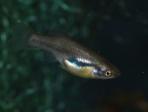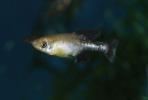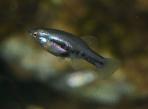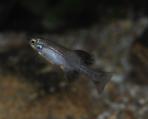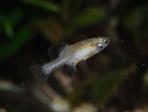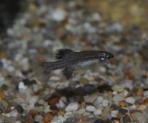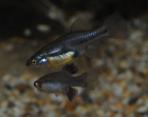Neotoca bilineata
BEAN, T. H. (1887): Descriptions of five new Species of Fishes sent by Prof. A. Dugès from the Province of Guanajuato, Mexico. Proceedings of the United States National Museum 10: pp 370-375
Collection-number: United States National Museum, Cat. No. USNM-37832.
The Holotype is an adult female of 44.9mm total length, collected by A. Dugès, collection date unknown. No other individuals were taken with this specimen.
The left picture shows a drawing of the Holotype, the right one compares a female Guppy (Poecilia reticulata) above with a female Neotoca bilineata below. This resemblance leads to severe impacts in Neotoca populations where Guppys cooccur (see also the chapter Remarks):
There is no Terra typica known for Neotoca bilineata. Bean supposed that "it is probable that the species described in this paper are from streams belonging to the Pacific slope of the Province of Guanajuato".
The species-name is derived from the Latin. The prefic bi- means "two", while lineatus origins from the noun linea, the line, and means "marked with a line". The epithet therefore means "marked with two lines", a colouration detail that this species shows mainly in preservation.
The genus Neotoca was erected by C. L. Hubbs and C. L. Turner (in Turner, 1937). The generic name is derived from the ancient Greek. The word νέος (néos) means new or young, and τόκος (tókos) offspring, so the name of the genus obviously refers to the different looking trophotaenia of the fry with the generic name meaning "new type of offspring".
The Twoline Skiffia is endemic to the Mexican federal states of Jalisco, Guanajuato and Michoacán. It was historically known from the upper sections of the Río Grande de Santiago, from the Laguna Chapala, the endorheic Río Grande de Morelia drainage including the Lago Cuitzeo and the Presa Cointzio, from the Laguna Yuriría and from habitats along the Middle Río Lerma and lowland habitats along the ríos Turbio and Guanajuato. It was historically known from 14 localities, however, within a survey conducted between 2000-2001 the species was only found in two localities (De La Vega-Salazar et al., 2003). Neotoca bilineata disappeared from the Río Gande de Santiago/ Laguna Chapala drainage, from the Río Lerma, where it must have been lived in the lower part as well, the Laguna Yuriría and possibly from the Río Guanajuato. It still can be found in the Río Grande de Morelia drainage including the Lago Cuitzeo and the Presa Cointzio and some localities along the Río Turbio around Penjamo (Presa Corralejo) and Abasolo (Lago El Pedregál). Affiliated to different drainages, five subpopulations can be inferred: the Middle Río Lerma subpopulation (type subpopulation), the Río Grande de Morelia subpopulation, the Laguna Yuriría subpopulation, the Río Grande de Santiago/ Laguna Chapala subpopulation, and - inferred from the range of the species, but not documented with Vouchers - the Lower Río Lerma subpopulation. The last three subpopulations are regarded Extinct. The bold names are the ones officially used by the Instituto Nacional de Estadística y Geografía; nevertheless, other ones might be more often in use or better known and therefore prefered.
ESU ist short for Evolutionarily Significant Unit. Each unit expresses an isolated population with different genetic characteristics within one species. ESU's can be defined by Molecular genetics, Morphology and/or Zoogeography and help in indicating different phylogenetic lineages within a species. The abbreviation for an ESU is composed of the first 3 letters of the genus, followed by the first 2 letters of the species name and an ongoing number in each species.
In Neotoca bilineata, we distinguish between the (probably) extinct populations from the Lago de Chapala drainage (Neobi1) and those from the other locations, encompassing the Lago de Cuitzeo drainage and the middle Río Lerma populations (ríos Guanajuato and Turbio). Those are named Neobi2.
The left map shows the Lago de Pátzcuaro-Cuitzeo y Lago de Yuriria (PC), the Río Lerma-Chapala (LC), the Río Lerma-Salamanca (LS), the Lago de Chapala (CH) and the Río Santiago-Guadalajara (SG) basins, all from the Hydrographic Region Lerma-Santiago on a Mexico map. The middle map shows the eastern subbasins, where in some of them the species still can be found, though sometimes in remnant popuations. It occurs in the Lago de Cuitzeo (CUI) subbasin, Lago de Pátzcuaro-Cuitzeo y Lago de Yuriria basin, and in the ríos Salamanca-Río Angulo (SAN), Solís-Salamanca (SOS) and Turbio-Corralejo (TCO) subbasins. There are no records over the last decade from the Lago de Yuriria (YUR) and the ríos Guanajuato (GUA) and Turbio-Manuel Doblado (TMD) subbasins. All of these subbasins belong to the Río Lerma-Salamanca basin. The right map shows western subbasins of this species. The historic distribution here has to be seen with a lot of scepticism as there are only few records available from the lagunas Chapala (CHA) and Chapala-Río Corona (COR) subbasins, most of them dating back to the early 1900's. Only one record from the Chapala lake from 1985 is a quite recent one, but the species identity needs confirming. However it is not a 100% sure if the Twoline Skiffia ever occured in habitats of the Lower Lerma river basin. If so, and we have to assume that at the moment by the existence of vouchers, it must have populated parts of the Río Lerma-Chapala basin, so are the ríos Duero (DUE), Briseñas-Laguna Chapala (BRI) and Angulo-Río Briseñas (ABR) subbasins, additionally the Río Sahuayo (SAH) subbasin from the Lago de Chapala basin and very likely the Río Corona-Río Verde (CVE) subbasin from the Río Santiago-Guadalajara basin:
International Union for Conservation of Nature (IUCN): Endangered
Distribution and current conservation status of the Mexican Goodeidae (Lyons et al., 2019): Endangered/declining: „Historically, this species was reported from three distinct areas: Lake Chapala and adjacent portions of its outlet, the upper Santiago River; the Lerma River and its tributaries the Laja River, Turbio River, and Lake Yuriria in the middle Lerma River basin; and the endorheic Lake Cuitzeo/Grande de Morelia River basin near the city of Morelia (Miller et al., 2005), but it has declined dramatically throughout its range. We recognize two ESUs based on genetic analyses (Ornelas-García et al., 2012). Neobi1, from Lake Chapala and vicinity, appears to be extinct with no captive populations. Most records are from the early 1900s, and no individuals have been collected there for at least 70 years (Lyons et al., 1998). Neobi2 is critically endangered and occupies the rest of the species’ range. Only a remnant population remains in the middle Lerma River near the city of Salamanca and in two small springs tributary to the Turbio River near Penjamo, and the species has been lost from the Laja River drainage and Lake Yuriria (Soto-Galera et al., 1998; Mercado-Silva et al., 2006; Mercado-Silva and Piller, unpublished data). Populations persist in the Lake Cuitzeo/Grande de Morelia River basin in Lake Cuitzeo, Cointzio Reservoir, Querendaro River, and Borbollon Springs, but none of these are particularly large and numbers fluctuate greatly within and among years. Pollution and habitat modifications had eliminated the species from nearly all of Lake Cuitzeo proper and from most of the Grande de Morelia River drainage before 2000 (Soto-Galera et al., 1999). Population declines have continued since then, and the long-term survival of this species in the wild is uncertain (De la Vega-Salazar et al., 2003; DomínguezDomínguez et al., 2005).“
NOM-059-SEMARNAT-2010: Categoría de riesgo (Category of risk): P - En Peligro de Extinción (in danger of extinction)
The habitats are quiet, turbid to muddy waters of lakes, sloughlike channels, ponds, ditches and canals. They can be found in depths of less than 1m over mud, silt, sand, clay and rocks, prefering currents of none to slight. The vegetation comprises green algae, water haycinths, Potamogeton, Chara, Typha and Scirpus.
Surveys of the GWG in 2014 and 2015 to the Cuitzeo lake found this species both times. The survey in November 2014 revealed many small fish and fry of about 1cm, the survey in January 2015 plainly less, but bigger individuals. In both surveys Neotoca bilineata was found in flooded grass in very shallow water of only a few centimetres, but also in murky water close to the shore. In a 2017 survey to the Turbio and Guanajuato rivers, the GWG was successful to find the Twoline Skiffia in two dams along the Río Turbio. In the Presa Corralejo, the group found beautifully coloured males and gravid females in flooded grass. The water was partly greenish from algae or covoured by a layer of Azolla sp., a swimming fern. The water was very shallow, maybe 30cm at its deepest. In the Lago El Pedregal , the species was hiding in riparian vegetation close to the bank or in very shallow water next to the shore. The water was deeper, probably down to 1m, but Neotoca prefered obviously the shallower (and warmer?) parts of the lake. The water was murky and greenish as well.
This species can tolerate low temperatures and produces offspring in water with a temperature of 10°C, nevertheless it was found on several surveys of the GWG from 2014-2017 in very shallow and partly surprisingly warm water. The temperature tolerance in both directions seem to be quite big. Captures of young and observations of females carrying embryos indicate that the reproduction occurs from early March to late May. Meek (1902) found 27 young fish in a female collected on May 26th near Huingo, Cuitzeo lake basin.
The gut is about 1.5 to slightly more than 2 times the length of the fish, and is herewith distinctly shorter than in Skiffia species. Both rows of teeth are bicuspid and loose, so all in all, this species seems to be microphagous-omnivorous, prefering tiny invertebrates, aufwuchs and detritus.
Both sexes are coloured silvery gray with a bluish or yellowish glimmer. Like in most Goodeid-species, the upper side is darker than the lower side. While courting, males develop a black dorsal and anal fin, the caudal fin a bit brighter, and become more colourful. The other fins are clear. On the sides appear 10 to 15 regular and thin vertical stripes. Usually, they become broader posteriorly. The first stripe is settled near the origin of the pectoral fin, the last on the caudal base. Some specimens show yellowish or orange pigments in the fins and on the caudal peduncle. Females may be coloured purplish or yellowish and show a silvery longitudinal stripe, extending from the eye posteriorly to the caudal base. All fins are clear. They show a black gravidy-spot in the anal region, varying in size.
At first appearance, males and females of the Twoline Skiffia might not always be easy to distinguish. The safest characteristic is the Splitfin in males, means the for Goodeinae typical mating organ formed by a notch after the first seven shortened rays of the Anal fin. Additionally, male Neotoca bilineatas are smaller and daintier and have a much bigger Dorsal fin than females. When males court, it is much easier with males getting black unpaired fins and displaying yellow and black colours on their flanks, while females stay bluish-grey with a gravity spot and and sometimes show a yellow belly.
T. H. Bean originally placed this species in the genus Characodon (1887) and Meek transfered it in 1902 in the genus Skiffia that he erected for Skiffia lermae. The reason therefore was a similar length of the intestines (though clearly shorter in Neotoca bilineata) and probably also the appearance as he had in contrary to Beans single female several individuals and for the first time males to study. Already he wrote the species might eventually deserve subgeneric rank, but his "material is too scant to warrant any such disposition of it being made at present". Hubbs & Turner showed in 1937, that the species differs in many characters like dentition, jaws, mouth, intestine length, colouration and sexual characters associated with the anal fin (Gonopodial suspension), and gave it full generic rank. Recent phylogenetic studies (Webb, Dominguez) support the individuality of Neotoca bilineata and see it either as a sister taxon to the genus Girardinichthys or place it on a basic position to both genera, Girardinichthys and Skiffia.
Neotoca bilineata is one of the oldest Goodeids in aquariums and had been imported to Europe already in 1935, but disappeared again during World War II. Additionally, in aquariums and in combination with higher temperatures, this species seem to stay rather small, reaching sometimes not even 3cm TL in the female sex (in the wild, females can reach up to 6cm TL). Males might not reach even 2cm in total.
Netoca bilineata is a kryptic species in the wild, hiding in vegetation and being distributed in particular habitats. It may be overlooked many times, but nevertheless, it has to be denoted as one of the most endangered species of Goodeids. It seems to persist at only few sites, most of them being tributaries to the Lago de Cuitzeo or the Turbio river. Additionally, the stocks might be extremly fluctuant as from the Lago de Cuitzeo, it wasn't reported anymore since the early 1990s when a survey of the GWG in November 2014 found hundreds of them. Eventually it is also fluctuant over the year when stocks explode in numbers during the rainy season (summer to late fall) and become low in numbers again over the dry season, being captured by the thousands by the many birds at waterbodies feeding from fish.
A study done by Ornelas-García et al. in 2012 focused on the genetic diversity of this species. In this study, two populations of the Lago de Cuitzeo and two of the Middle Río Lerma basin were included. On the one hand, they discovered two clades. One including fish from the Cuitzeo lake populations, another one with the Lerma river populations and one population of the Cuitzeo lake. One explanation for this not clear result they gave was a secondary connection of both clades through the La Cinta channel, that connects via the Yuriria lake the Cuitzeo lake with the Lerma river, but according to Domínguez-Domínguez (pers. com.), this channel was opened only once many years ago. However, the populations showed high genetic diversity in mtDNA and Microsatellite Markers. On the other hand the authors also pointed on the disastrous situation of the habitats where Neotoca bilineata occured. Waste water, habitat modifications and exotic species brought this species at the brink of extinction. Few years before, Valero et al. (2008) reported of negative interactions between Poecilia reticulata and Neotoca bilineata as a consequence of courtship and forced copulation attempts. Persistent courtship by male guppies is likely to impose significant costs on Neotoca females, particularly since it occurs at a higher rate than courtship from their own species. Additionally, the Guppy’s hooked gonopodium can cause injury to even conspecific females during mating, so it is probable that Neotoca females, lacking defences against hooked gonopodia, will suffer cloacal damage during mating attempts.
Looking on the biotopes of Neotoca bilineata, they suggest the species may prefer a habitat with none to moderate current, structured with gravel, rocks, roots, branches, fallen leaves and a lot of submerse or/and river bank vegetation. Fry is usually not eaten, but it may depend on the quantity and quality of food and on the number of places to hide. When the circumstances for this species are good, it is easy to get a flock breeding colony.
The recommended tank size is at least 60 liters, bigger tanks are not really necessary, but the tank should not be too high (15 to 20cm are enough). With some rocks or roots and dense vegetation well structured tanks combined with dead leaves seem to do best with this species. The current should be none to moderate. However, this species seems to be the only one accepting a lower oxygene level (at least 6mg/l).
In the wild, the species feeds mainly from small invertebrates like Copepods or insect larvae, aufwuchs and detritus, so feeding with similar food like water fleas and other food from animalistic sources will be best for this fish. In aquarium, it feeds also from frozen or freeze dried food and even tablets, flake food or granulate. Additionally given Nauplia of Brine Shrimps are eaten greedy and might be an essential part of feeding. The species doesn't act shy.
Concerning water quality, this species is not in need of bigger water changes (20-30% every second week are enough). Nevertheless, keep an eye on the water quality. Otherwise, in combination with constant temperatures higher than 24°C, fish may get sick, lose resistance against diseases and age too fast. So for keeping the strain healthy and strong, give the fish a rest during winter time with temperatures lower than 20°C for 2 or 3 months so they stop producing fry. In spring, when the temperature slowly increases, they will start spawning at 17 or 18°C and won't stop until it gets colder again or when it gets too warm (24°C).
This species is doing very well when is kept in the open from spring to fall, starting when the water temperature by day exceeds 15°C and cold periods are no longer expected. Bring them out in the early afternoon, the time of the day with the highest water temperature. During the warm summer, reproduction will stop and may occur again in fall. Bring the fish in before the water temperature deceeds 15°C by day and keep them cool for the first days, then slowly raise the temperature but try to stay below 20°C over the winter time.






